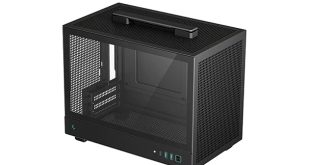The first move during the installation phase is to remove the aluminum beam from the inside of the case. There are four screws holding this in place. This can be returned when the system is complete, although I have to be honest, once I remove this, it never goes back in. If you are the kind of person who builds a system once and never touches the insides again, then it is a good idea to put this back.
The power supply rests on the raised platform at the bottom of the case. There are two rubber lined support strips here to reduce vibration noise.
We love the Lian Li power supply fitting procedure. They supply a locking bracket which attaches to the backplane of the case. With this in place Lian Li say you don't need to attach the four mounting screws at the rear of the case, unless you move the system regularly, such as for LAN events. We recommend you bolt it in anyway, as the procedure only takes a few minutes. This concept is ideal however for a reviewer or developer who makes frequent changes to a system build.
The PC-Z70 front panel can be removed by simply tugging on the sides. Each of the hot swappable drive bays is protected by a locking mechanism, which is released by thumbscrews. This were in place rather tightly, so we removed them with a screwdriver.
The internal bar mechanism can be removed with the supplied keys.
The case supports both 3.5 inch and 2.5 inch drives. Lian Li include a plethora of plastic mounting brackets which attach to the side of each of the drives. The hard drives can then slide into place and lock into the rear data PCB on each of the drive bays.
2.5 inch drives can be installed directly into a smaller bay at the bottom of the case as shown above. At Kitguru, we don't use internal optical drives any more, prefering to rely on a USB 2.0 powered bluray drive, or USB drive media for application installs. The installation procedure for 5.25 inch products is the same however.
The PC-Z70 case has literally acres of room inside for building a system.
Quite often we feel that many case manufacturers overlook routing support. This time however Lian Li have gotten it spot on – there are rubber protected routing holes scattered across the outer edges of the ATX motherboard area, meaning that all cables can be fed in from the back without a problem.
Building a system in this case was as painfree as we have experienced, and just as impressive as the X2000F chassis we reviewed in March. The image above highlights the potential for cable routing, although the molex connectors would need to be moved to the rear of the motherboard tray to clean up the overall appearance.
 KitGuru KitGuru.net – Tech News | Hardware News | Hardware Reviews | IOS | Mobile | Gaming | Graphics Cards
KitGuru KitGuru.net – Tech News | Hardware News | Hardware Reviews | IOS | Mobile | Gaming | Graphics Cards
















